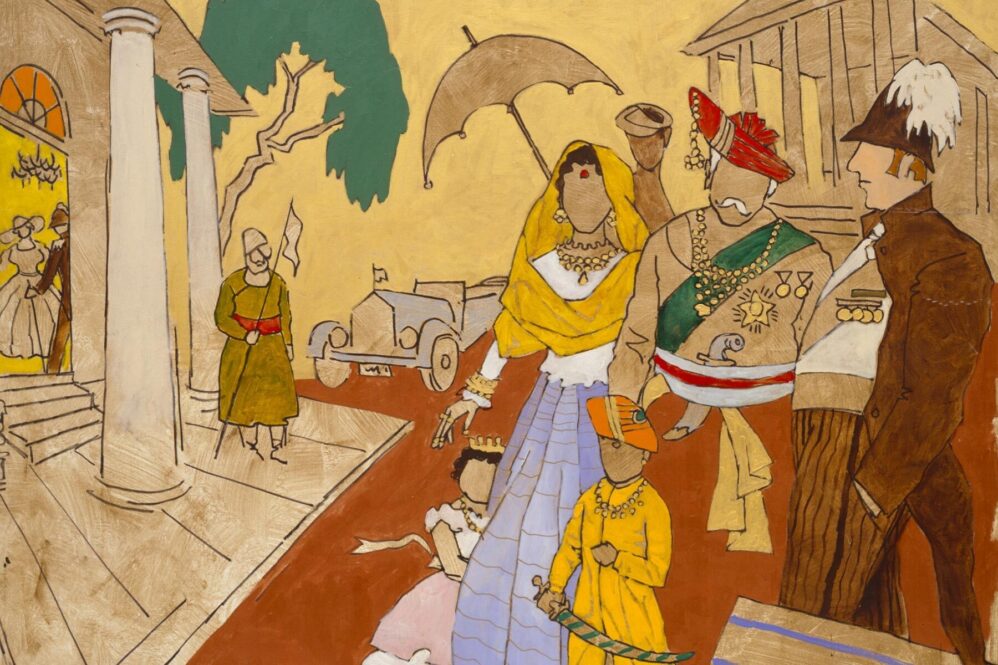Collection
South Asian Art
Rooted in intercultural influence and exchange, PEM’s South Asian collection celebrates the diversity of the region’s rich creative output and its people.

By the end of the 18th century, Salem merchants had joined their European rivals in the lucrative trade with South and Southeast Asia.
The earliest American traders who traveled to the Indian subcontinent went in search of silk, cotton and fragrant sandalwood, as well as sugar, ginger and indigo. India was then, and remains today, a land of tremendous diversity and paradox — a vast multitude of cultures, languages and faiths, where the distant and more recent pasts are still felt in the present.
PEM’s collection prioritizes works from the 18th century to today that speak of global interaction. Among the highlights of PEM’s historic South Asian collection are its internationally renowned holdings of 19th-century Kalighat paintings. Taking their name from a temple to the goddess Kali, these lively watercolors were first sold to local laypeople and later became popular with Western travelers seeking inexpensive curiosities and conversation pieces to take home.
In 2001, the transformative gift of the Chester and Davida Herwitz collection of 20th-century Indian art established PEM as the first museum outside of India to focus on the achievements of the country’s modern artists, including painters already well established in India such as M.F. Husain and Tyeb Mehta, as well as Atul Dodiya and Nalini Malani. These works speak not only of India’s struggles and dreams as an independent nation, but also of the bonds between artists and their admirers.
All the Flowers Are for Me, Anila Quayyum Agha’s immersive installation, signaled PEM’s first major acquisition of a work by an artist of Pakistani descent. The collection also includes works from Sri Lanka, Indonesia, Nepal and Bhutan, including an exceptional group of Bhutanese textiles.
Highlights from this collection

Woman ’95, 1995
G. Ravinder Reddy (b. 1956, India), Woman ’95, 1995. Fiberglass and gilding. Gift of the Chester and Davida Herwitz Collection, 1999, E300456.
On view in the South Asian Art Gallery.

August ‘81, 1981
Biren De (1926–2011, India), August ‘81, 1981. Oil on canvas. Gift of the Chester and Davida Herwitz Collection, 2001. E301030.
On view in the South Asian Art Gallery.

Man, 1951
Maqbool Fida (M.F.) Husain (1915–2011, India), Man, 1951. Oil on fiberboard. Gift of the Chester and Davida Herwitz Collection, 2001. E301146. Estate of M.F. Husain.
On view in the South Asian Art Gallery.

Hanuman Revealing Rama and Sita in his Heart, 19th century
Artists in Kolkata, India, Hanuman Revealing Rama and Sita in his Heart, 19th century. Watercolor and tin on paper. Museum purchase, made possible by an anonymous donor, 2003. E302104.

Bindu La Terre, 1983
Sayed Haider (S.H.) Raza (1922–2016, India), Bindu La Terre, 1983. Oil on canvas. Gift of the Chester and Davida Herwitz Collection, 2003. E301248.

Untitled, 1973
Tyeb Mehta (1925–2009, India), Untitled, 1973. Acrylic on canvas. Gift of the Chester and Davida Herwitz Collection, 2001. E301099. Courtesy of the Estate of Tyeb Mehta.
On view in the South Asian Art Gallery.

2nd October, 1993
Atul Dodiya (b. 1959, India), 2nd October, 1993. Acrylic and oil on canvas. Gift of the Chester and Davida Herwitz Collection, 2001. E301092.
On view in the South Asian Art Gallery.

Old Arguments on Indigenism, 1989
Nalini Malani (b. 1946, India), Old Arguments on Indigenism, 1989. Acrylic and oil on canvas. Gift of the Chester and Davida Herwitz Collection, 2001. E301088.
On view in the South Asian Art Gallery.

Protector Goddess, mid-19th century
Artists in Kerala, India, Protector Goddess, mid-19th century. Wood and pigment. Gift of Robert P. Gay, 1921. E18001.
On view in Powerful Figures.

Devotee of Krishna, about 1823
Kashinath Pal in Krishnanagar, Devotee of Krishna, about 1823. Unfired clay, paint, textile. Gift of Captain James Buffington Briggs/Capt. Benjamin Vanderford, 1823. E9923.
On view in the South Asian Art Gallery.

Two Men with Hand Cart, 1979
Gieve Patel (b. 1940, India), Two Men with Hand Cart, 1979. Oil on canvas. Gift of the Chester and Davida Herwitz Collection, 2003. E301289.
On view in the South Asian Art Gallery.

Girl Eating Rasagolla, 1980
K.G. Subramanyan (1924–2016, India), Girl Eating Rasagolla, 1980. Reverse painting on acrylic. Gift of the Chester and Davida Herwitz Collection, 2001. E301396.
On view in the South Asian Art Gallery.

Loans and acquisitions
PEM is committed to providing the broadest possible access to its collection through the loan of objects for educational and scholarly purposes. Learn how to request a loan from the museum’s collection.
Keep exploring
Exhibition
South Asian Art
Ongoing

Blog
India and its people
6 min read

Blog
Telling the story of the Mahabharata
4 min read

Blog
Giving light
6 min read
